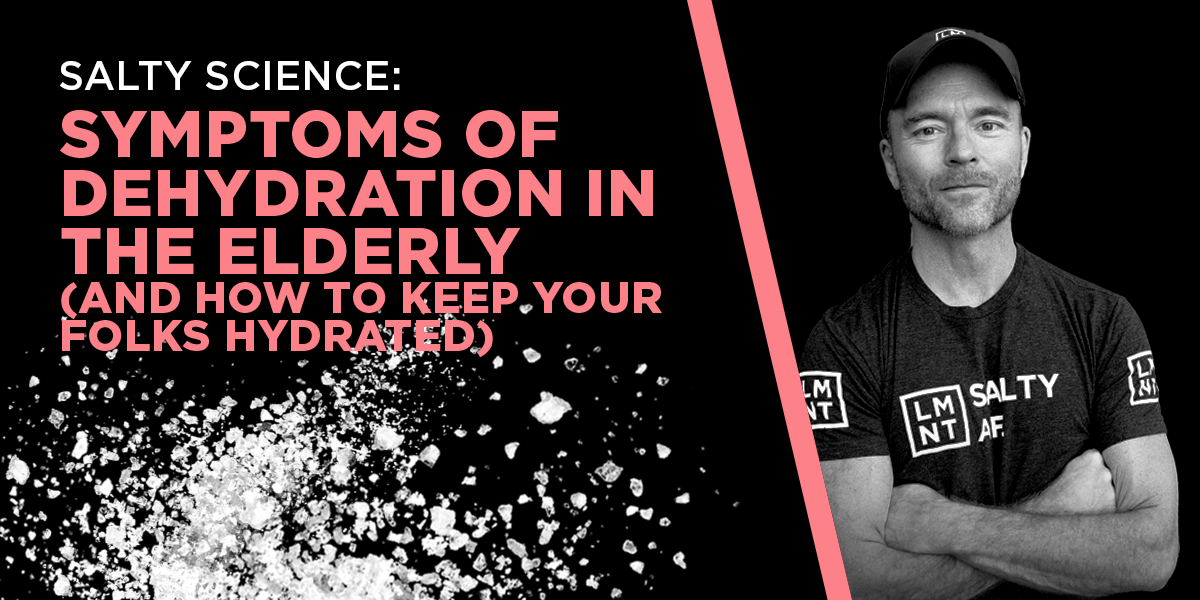I get asked a lot about symptoms of dehydration in the elderly. As it turns out, many older folks have a different notion of what it means to stay hydrated.
Given the widespread misinformation on dehydration, overhydration, and everything in between, I can’t blame them. We need to get better at disseminating scientific knowledge, rather than catchy, homespun wisdoms.
Fun fact: Researchers have actually quantified the hydration literacy of older folks. Here are some interesting tidbits from their survey of 170 people living in elderly communities:
- Over half the respondents reported drinking over 6 glasses of water per day. (That’s a lot!).
- About 60% overestimated the amount of fluid loss needed to cause moderate to severe dehydration symptoms.
- Very few understood the signs, symptoms, and significance of overhydration.
I know, 6 glasses a day (~12 cups) sounds like a decent place to be. The old adage “drink at least 8 cups of water a day” isn’t doing us any favors. We’ll get to busting that myth in a moment.
Maybe you’re doing your own research, or perhaps you’re learning how to help keep your parents in good health with proper hydration. Whichever spot you’re in, I wrote this article as your guide to hydration for the elderly. Let’s dig in.
What Is Dehydration?
Dehydration is defined as net water loss from the body. Mild dehydration starts around 1% loss of total body water, while moderate to severe dehydration sets in anywhere from 3-5% loss, depending on who you ask.
Clinically, you can assess dehydration status by weight fluctuations or blood osmolality (the concentration of electrolytes in serum), but both measures are imperfect. In most cases, reviewing dehydration symptoms (headache, fatigue, dry mouth, dark urine, low blood pressure, etc.) in tandem with known fluid intake is the best method.
There are many causes of dehydration, from medications to illness to sweating. I like to boil them down into four main categories:
- Water loss through the skin. Warm temperatures, humidity, lack of breeze, clothing, exercise intensity, and various medical conditions all influence sweat loss.
- Water loss through the gut. Diarrhea, vomiting, and laxatives all increase water losses.
- Water loss through urine. Any intervention with a diuretic effect (fasting, the keto diet, diuretic drugs) will increase urinary fluid losses.
- Insufficient water consumption. This is a major cause of dehydration in the elderly. I’ll explain why in a moment.
Despite this laundry list of causes, healthy people rarely become dehydrated. Why? Because most people have a properly functioning thirst mechanism.
The mechanism is brilliant. All the time, receptors in a brain region called the hypothalamus are measuring blood volume and electrolyte levels. If your blood volume is low or osmolality is high, it makes you thirsty. Then you drink something and fluid balance is restored.
Dehydration, however, tends to hammer the elderly more than other people. Let’s explore why.
Why Are Older People More Likely to Become Dehydrated?
Depending on the source, anywhere from 17 to 28% of elderly people suffer from dehydration. This is a much higher rate than the average population, and there are several explanations for this phenomenon.
The first concerns the thirst mechanism. As we age, thirst receptors in the hypothalamus (along with everything else) tend to degenerate. This can break the thirst mechanism.
Older people also tend to lose more fluids due to urinary incontinence (an inability to control the bladder) and fecal incontinence (an inability to control bowel movements).
There’s also the unfortunate fact of age-related immobility. If you can’t walk to the fridge, you can’t get a glass of water.
But I believe the biggest cause of hydration issues in the elderly is a lack of hydration literacy. For instance, if you believe that fluid intake doesn’t impact sodium status (as most respondents in the aforementioned survey did), your hydration methods probably won’t be optimal.
Symptoms of Dehydration
Here are the main dehydration symptoms to watch for in folks of all ages:
- Thirst
- Dark urine
- Dry skin and lips
- Decreased urinary volume
- Headaches
- Memory issues
- Irritability
- Muscle cramps
- Fatigue
- Constipation
- Lower blood pressure
- Seizures
- Nausea
- Fainting
- Feeling lightheaded or dizzy
- Rapid heartbeat (tachycardia)
The last several symptoms—low blood pressure, nausea, seizures, fainting, dizziness, and tachycardia—are signs of severe dehydration. In extreme cases, dehydration can result in death. Most of the survey respondents were not aware of this.
Since dehydration symptoms are nonspecific, they’re commonly mistaken for other conditions. The inverse is also true: other conditions (like hyponatremia) are commonly mistaken for dehydration.
It’s easy to mistake hyponatremia (low serum sodium) for dehydration. Many of the symptoms—muscle cramps, dizziness, brain fog, fatigue, seizures, cognitive issues—overlap.
Unfortunately, the remedy for dehydration (drink more water) is opposite the remedy for hyponatremia (drink less water and consume more sodium). In other words, drinking more water can exacerbate symptoms by further diluting blood sodium levels. This is counterintuitive as folks generally only think about “dehydration” while ignoring the (arguably) larger problem of hyponatremia.
The Problem of Overhydration
You’ve probably heard of the 8×8 rule. This turd of conventional wisdom holds that we should drink 8 glasses of water 8 times per day for optimal health.
But there isn’t any science behind this homespun detritus. Rather, there’s science against it.
For example, drinking on a set schedule (rather than drinking to thirst) is a primary cause of hyponatremia, a condition that reliably debilitates elite endurance athletes. Many athletes have perished from exercise-associated hyponatremia, while none (according to the literature) have perished from dehydration.
Hyponatremia is an underappreciated problem for the elderly. As you’ll recall, over half of the 170 elderly participants reported drinking more than 6 glasses of water per day—ostensibly to prevent dehydration.
But few of these folks were aware of the dangers of overhydration. Consider that:
- The majority of respondents did NOT believe that reducing fluid intake could affect sodium status.
- Very few respondents knew that seizures, brain damage, and death could result from overhydration.
- About one-third of respondents didn’t understand that heart or kidney failure could lead to fluid overload.
The last point is especially relevant to the older set. In cases of heart failure, the heart is unable to pump fluids efficiently throughout the body. This, unfortunately, results in ankle swelling and other overhydration symptoms.
Heart failure patients are often prescribed diuretics to clear excess fluids. Many are advised to restrict fluids to 1 to 1.5 liters per day. A similar danger presents with kidney failure, another common condition in elderly folks. When the kidneys can’t clear excess fluids, tissues can swell and sodium levels can plummet.
But heart and kidney failure aren’t the only causes of hyponatremia. Liver disease, cancer, vomiting, diarrhea, diuretic usage, and overhydration are also common drivers. That’s right, the simple act of drinking too much sodium-free water is sufficient. How much is too much?
That’s hard to say. It varies by individual. Typically I recommend drinking to thirst, and I believe this general rule holds for the elderly. But in cases of a misfiring thirst mechanism, some adjustments may be necessary.
Proper Hydration for the Elderly
Most people, not just the elderly, are confused about hydration. They think healthful hydration is all about drinking water.
It’s not. It’s about consuming the proper amount of fluids AND electrolytes to support fluid balance, energy levels, and overall health.
Fluid balance is a key concept here. And thanks to the kidneys and an elegant assortment of hormones, the human body does a nice job maintaining proper fluid levels in various tissues without any conscious direction.
But the body needs help. It needs the conscious human to:
- Consume adequate fluids
- Consume adequate electrolytes
Let’s address these points with a special focus on older folks.
#1: Adequate Fluids for the Elderly
Elderly people are more likely to become dehydrated due to mobility issues, incontinence, and problems with thirst. Arranging easy fluid access and drinking to thirst (to prevent overhydration) should solve the first two issues, but what if thirst itself is broken?
Two quick ideas. First, pay attention to symptoms like dark urine and low urinary volume as signs of dehydration. These symptoms generally don’t indicate hyponatremia.
Second, take sodium along with fluids. This will prevent the dilution of blood sodium levels and the resulting low sodium symptoms.
I teamed up with my former coaches to create the best electrolyte drink mix on the market. It’s called LMNT, and it contains zero sugar, 1 gram sodium, 200 mg potassium, and 60 mg magnesium.
Essential nutrients for optimal functioning, minus all of the BS found in typical “sports” drinks that you don’t need. It also tastes unbelievably good, in my humble opinion.
#2: Adequate Electrolytes for the Elderly
I’m going to be controversial here. I think the main cause of dehydration symptoms in the elderly isn’t dehydration, but rather low electrolytes. Sodium is the biggest one. Just like dehydration, inadequate sodium can cause cramps, headaches, lethargy, and brain fog.
And most elderly people seem to be drinking plenty of fluids. Over half the elderly respondents drank six or more glasses per day, while only 9% drank 3 or fewer glasses.
But since sodium has been falsely maligned for decades as being bad for heart health, most elderly folks avoid it as much as possible.
The solution is simple: get enough sodium. Based on published data, I recommend shooting for 4–6 grams of sodium per day, which is about 2–3 teaspoons of salt. That was the level of sodium consumption linked to the lowest level of heart attacks and strokes in high-risk patients—and barring medical considerations, it’s plenty to prevent hyponatremia in non-athletes.
So drinking to thirst, monitoring urine color and output, consuming electrolyte water, and keeping the salt shaker handy—these are the strategies I recommend to help elderly folks stay hydrated. Give them a try and I think you’ll find them quite useful.

